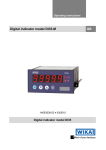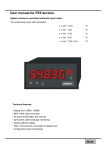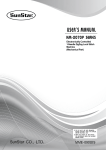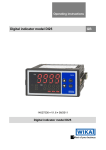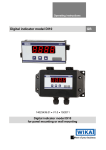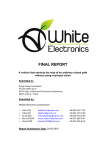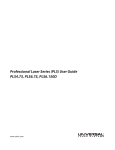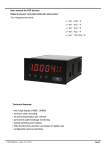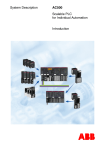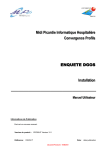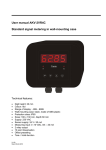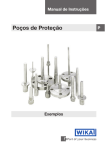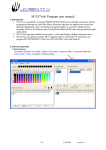Download Operating instructions #1
Transcript
Operating instructions Digital indicator model DI35-D 14053540.03 03/2015 Digital indicator model DI35 GB GB Operating instructions model DI35-D page 1 - 52 © 2015 WIKA Alexander Wiegand SE & Co. KG All rights reserved. WIKA® is a registered trademark in various countries. Prior to starting any work, read the operating instructions! Keep for later use! 2 WIKA operating instructions digital indicator DI35-D Contents 1 2 General information ................................................................................4 Safety .......................................................................................................5 2.1 2.2 2.3 2.4 3 4 Intended use........................................................................................5 Personnel qualification.........................................................................7 Special hazards ...................................................................................7 Labelling / Safety marks ......................................................................8 Specifications ..........................................................................................9 Design and function ..............................................................................13 4.1 Short description................................................................................13 4.2 Scope of delivery ...............................................................................13 5 Transport, packaging and storage .......................................................14 5.1 Transport ...........................................................................................14 5.2 Packaging..........................................................................................14 5.3 Storage ..............................................................................................14 6 Commissoning, operation ....................................................................15 6.1 6.2 6.3 6.4 6.5 6.6 6.7 6.8 6.9 7 Mounting............................................................................................15 Electrical connection ..........................................................................16 Function and operation description ....................................................21 Configuration of the indicator .............................................................29 Description of the measuring input ....................................................31 Working principle of single or dual channel measurement .................34 Description of the program numbers ..................................................36 Program number table .......................................................................43 Default values ....................................................................................47 Maintenance and cleaning ....................................................................47 7.1 Maintenance ......................................................................................47 7.2 Cleaning ............................................................................................47 8 9 Faults .....................................................................................................48 Dismounting, return and disposal .......................................................50 9.1 Dismounting ......................................................................................50 9.2 Return ...............................................................................................50 9.3 Disposal.............................................................................................50 10 Appendix: Declaration of conformity...................................................51 Declarations of conformity can be found online at www.wika.com. WIKA operating instructions digital indicator model DI35-D 3 1 General information 1 General information The instrument described in the operating instructions has been designed and manufactured using state-of-the-art technology. All components are subject to stringent quality and environmental criteria during production. Our management systems are certified to ISO 9001. These operating instructions contain important information on handling the instrument. Working safely requires that all safety instructions and work instructions are observed. Observe the relevant local accident prevention regulations and general safety regulations for the instrument's range of use. The operating instructions are part of the instrument and must be kept in the immediate vicinity of the instrument and readily accessible to skilled personnel at any time. Skilled personnel must have carefully read and understood the operating instructions, prior to beginning any work. The manufacturer's liability is void in the case of any damage caused by using the product contrary to its intended use, non-compliance with these operating instructions, assignment of insufficiently qualified skilled personnel or unauthorised modifications to the instrument. The general terms and conditions, contained in the sales documentation, shall apply. Subject to technical modifications. Further information: - Internet address: - Relevant data sheet: - Application consultant: 4 www.wika.de / www.wika.com AC 80.03 Tel.: (+49) 9372/132-0 Fax: (+49) 9372/132-406 E-Mail: [email protected] WIKA operating instructions digital indicator DI35-D 2 Safety Explanation of symbols WARNING! ... indicates a potentially dangerous situation that can result in serious injury or death, if not avoided. Information ... points out useful tips, recommendations and information for efficient and trouble-free operation. DANGER! ...identifies hazards caused by electric power. Should the safety instructions not be observed, there is a risk of serious or fatal injury. 2 Safety WARNING! Before installation, commissioning and operation, ensure that the appropriate instrument has been selected in terms of measuring range, design and specific measuring conditions. Non-observance can result in serious injury and/or damage to equipment. Further important safety instructions can be found in the individual chapters of these operating instructions. 2.1 Intended use The digital indicator DI35-D is used for measurement and indication of standard signals 0/4 ... 20 mA and 0 ... 10 V via two inputs. There are four basic arithmetic operators (+ - * /) and an additional constant multiplier available for calculations on the input signals. One of the two input signals, or a value calculated as a function of the two input signals, can be displayed. One Signal can be put out via an analogue output for further processing. WIKA operating instructions digital indicator model DI35-D 5 2 Safety The instrument has been designed and built solely for the intended use described here, and may only be used accordingly. Please read the following safety advice and the assembly before installation and keep it for future reference. If the instrument is transported from a cold into a warm environment, the formation of condensation may result in the instrument malfunctioning. Before putting it back into operation, wait for the instrument temperature and the room temperature to equalise. Notes on installation There must be no magnetic or electric fields in the vicinity of the device, e.g. due to transformers, mobile phones or electrostatic discharge. Do not install inductive consumers (relays, solenoid valves etc.) near the device and suppress any interference with the aid of RC spark extinguishing combinations or free-wheeling diodes. Keep input, output and supply lines separate from one another and do not lay them parallel with each other. Position “go” and “return lines” next to one another. Where possible use twisted pair. So, you receive best measuring results. Screen off and twist sensor lines. Do not lay current-carrying lines in the vicinity. Connect the screening on one side on a suitable potential equaliser (normally signal ground). Do not install several devices immediately above one another or in an extremely thermal isolated housing. Due to the internal heat dissipation of the devices, the recommended ambient temperature can be excessed. The device is not suitable for installation in areas where there is a risk of explosion. Any electrical connection deviating from the connection diagram can endanger human life and/or can destroy the equipment. The terminal area of the devices is part of the service. Here electrostatic discharge needs to be avoided. Attention! High voltages can cause dangerous body currents. Galvanic insulated potentials within one complex need to be placed on a appropriate point (normally earth or machines ground). So, a lower disturbance sensibility against impacted energy can be reached and dangerous potentials, that can occur on long lines or due to faulty wiring, can be avoided. The fuse rating of the supply voltage should not exceed a value of 6A N.B. fuse. 6 WIKA operating instructions digital indicator DI35-D 2 Safety The manufacturer shall not be liable for claims of any type based on operation contrary to the intended use. 2.2 Personnel qualification WARNING! Risk of injury should qualification be insufficient! Improper handling can result in considerable injury and damage to equipment. The activities described in these operating instructions may only be carried out by skilled personnel who have the qualifications described below. Keep unqualified personnel away from hazardous areas. Skilled electrical personnel Skilled electrical personnel are understood to be personnel who, based on their technical training, knowledge of measurement and control technology and on their experience and knowledge of country-specific regulations, current standards and directives, are capable of carrying out work on electrical systems and independently recognising and avoiding potential hazards. The skilled electrical personnel have been specifically trained for the work environment they are working in and know the relevant standards and regulations. The skilled electrical personnel must comply with current legal accident prevention regulations. 2.3 Special hazards DANGER! Danger of death caused by electric current. Upon contact with live parts, there is a direct danger of death. Electrical instruments may only be installed and mounted by skilled electrical personnel. Operation using a defective power supply unit (e.g. short circuit from the mains voltage to the output voltage) can result in life-threatening voltages at the instrument! WIKA operating instructions digital indicator model DI35-D 7 2 Safety WARNING! Do NOT use this product as safety or emergency stopping device, or in any other application where failure of the product could result in personal injury or material damage. Failure to comply with these instructions could result in death or serious injury and material damage. 2.4 Labelling / Safety marks Product label Explanation of symbols Before mounting and commissioning the instrument, ensure you read the operating instructions! CE, Communauté Européenne Instruments bearing this mark comply with the relevant European directives. 8 WIKA operating instructions digital indicator DI35-D 3 Specifications 3 Specifications Specifications Display Principle Character size Indication range Indication time Memory Input Number and type Input configuration Accuracy Temperature error Measuring principle Resolution Measuring time Transmitter supply Power supply Power consumption Electrical connection {Analogue output} Number and type Error Internal resistance 7-segment LED, red, 5-digit, brightness adjustable in 10 steps 14 mm -9999 … +99999 0.1…10.00 sec EEPROM (independent of power supply), data retension > 100 years 2 inputs for standard signals: 0…20 mA, RI = ~ 50 Ω 4…20 mA, RI = ~ 50 Ω 0…10 V, RI = ~ 150 kΩ Selectable via terminal configuration and programming See datasheet AC 80.03 50 ppm/K, at ambient temperature T < 20 °C or > 40 °C Sigma/Delta 24 bit, (at measuring time 1 second) Single channel measurement: 0.02…10.0 sec Dual channel measurement: 0.04…10.0 sec DC 24 V, 50 mA AC 100...240V, 50/60 Hz, ± 10 % or {DC 10...40V, AC 18...30V, 50/60 Hz} Power supply galvanic insulated max. 15 VA plug-in terminal, wire cross-section up to 2.5 mm² 1 analogue output (galvanic insulated): 4 ... 20 mA (12-bit), load ≤ 500 Ω, 0 ... 20 mA (12-bit), load ≤ 500 Ω, 0 ... 10 V (12-bit), load ≥ 10 kΩ switchable (via programming or DIP-Switch on back) 0.1% in the range 20 °C ≤ Tu ≤ 40 °C, beyond this value temperature error 50 ppm/K 100 Ω WIKA operating instructions digital indicator model DI35-D 9 3 Specifications {Switching outputs} number and type 2 or 4 change-over contacts (relays), fully programmable AC 230 V, 5 A (ohmic load) or DC 30 V, 2 A (ohmic load) 0.5 * 105 at max. contact rating 5 * 106 mechanically Separation as per DIN EN 50178 Characteristic data as per DIN EN 60255 RS 232, selectable with or without galvanic isolation or RS 485 (only for point-to-point connection), selectable with or without galvanic isolation manufacturer-specific ASCII 9600 Baud, no parity, 8 data bits, 1 stop bit RS 232: max. 3 m RS 485: max. 1000 m Load Switching cycles {Serial Interface} Protocol communication Lead length Case Material Ingress protection Glass fibre reinforced polycarbonate, black Front: IP 65; Back: IP 00 (per IEC 60529 / EN 60529) 96 x 48 x 139 mm (w x h x d) including plug-in terminals Approx. 450 g snap-in screw element for wall thickness up to 50 mm Dimensions Weight Mounting {Desktop case}* Material Front, back and side panel aluminium powdercoated black, top and baseplate synthetic resin bonded paper (Pertinax) IP40 170 x 82 x 250 mm (w x h x d) Ca. 1600 g Ingress protection Dimensions Weight * only available for DI35-D Permissible ambient conditions Operating temperature 0…60 °C Storage temperature -20…80 °C Humidity 0…75 % relative humidity, non-condensing 10 WIKA operating instructions digital indicator DI35-D 3 Specifications CE conformity EMC directive 2004/108/EC, EN 61326 emission (group 1, class B) and interference immunity (industrial application) 2006/95/EG, EN 61010-1 Low voltage directive { } Items in curved brackets are optional extras for additional price. Accuracy of input signals Input Measuring span signals Current signals 0…20 mA 4…20 mA Voltage signal 0…10 V Measuring error in % of Inner the span resistance ± 0.02 % ± 1 Digit ± 0.02 % ± 1 Digit 50 Ω 50 Ω ± 0.02 % ± 1 Digit 150 kΩ The measuring errors are valid for ambient temperatures of 20…40 °C and a measuring time of 1 second. Adjustable measuring times Input signal Current signals Voltage signal Measuring time in seconds Single channel Dual channel measurement measurement 0.02…10.00 0.04…10.00 0.02…10.00 0.04…10.00 For further specifications see WIKA data sheet AC 80.03 and the order documentation. WIKA operating instructions digital indicator model DI35-D 11 3 Specifications Operating elements 1: Program key 2: DOWN key 3: UP key 4: Multi-function key 12 5: 7 segment display 6: Slot for sign marking the dimension 7: LEDs for alarm output WIKA operating instructions digital indicator DI35-D 4 Design and function 4 Design and function 4.1 Short description The digital indicator DI35-D is a highly accurate indicator which features two inputs for standard signals 0/4 ... 20 mA and 0 ... 10 V, which can be combined as required. One of the two input signals, or a value calculated as a function of the two input signals, can be displayed. The four basic arithmetic operators (+ - * /) and an additional constant multiplier are available for calculations on the input signals. Furthermore the possibility of sensor calibration and linearisation with up to 30 points is offered. The standard features are completed by an integrated transmitter power supply, the adjustable sampling rate and display time as well as the input offset for the correction of zero offsets or sensor drifts and TARA and HOLD function. The measured value or one of the functions can be indicated and used as output signal. As an option up to 4 fully programmable alarm outputs, an analogue output signal and a serial interface are available. 4.2 Scope of delivery The scope of delivery is: Indicator 2 fixing elements Seal Operating instructions Cross-check scope of delivery with delivery note. WIKA operating instructions digital indicator model DI35-D 13 5 Transport, packaging and storage 5 Transport, packaging and storage 5.1 Transport Check instrument for any damage that may have been caused by transport. Obvious damage must be reported immediately. 5.2 Packaging Do not remove packaging until just before mounting. Keep the packaging as it will provide optimum protection during transport (e.g. change in installation site, sending for repair). 5.3 Storage Permissible conditions at the place of storage: Storage temperature: -20 ... +80 °C Humidity: 0 ... 75 % relative humidity (no condensation) Avoid exposure to the following factors: Direct sunlight or proximity to hot objects Mechanical vibration, mechanical shock (putting it down hard) Soot, vapour, dust and corrosive gases Potentially explosive environments, flammable atmospheres Store the instrument in its original packaging in a location that fulfils the conditions listed above. If the original packaging is not available, pack and store the instrument as described below: 1. Wrap the instrument in an antistatic plastic film. 2. Place the instrument, along with shock-absorbent material, in the packaging. 3. If stored for a prolonged period of time (more than 30 days), place a bag, containing a desiccant, inside the packaging. WARNING! Before storing the instrument (following operation), remove any residual media. This is of particular importance if the medium is hazardous to health, e.g. caustic, toxic, carcinogenic, radioactive, etc. 14 WIKA operating instructions digital indicator DI35-D 6 Commissoning, operation 6 Commissoning, operation Please read the safety instructions and installation instructions in chapter 2 before installation and keep this user manual for future reference. 6.1 Mounting Panel cut out: Assembly grid: 92,0+0,8 mm x 45,0+0,6 mm 120 mm horizontal, 96 mm vertical (recommended) 1. After removing the fixing elements, insert the device. 2. Check the seal to make sure it fits securely. 3. Click the fixing elements back into place and tighten the clamping screws by hand. Information The dimension symbols can be exchanged before installation via a channel on the side! WIKA operating instructions digital indicator model DI35-D 15 6 Commissoning, operation 6.2 Electrical connection All the necessary signals for operation are connected to the rear terminals. The connecting terminals are designed as removable screw-type terminals with a grid pitch of 5.08 mm. This makes it possible to connect wires of up to 2.5 mm². 6.2.1 Terminal configuration Lower terminal connector The power supply, the input signal, the transmitter supply and the analogue output signal have to be connected to the lower terminal connector. The mounting screws for the transmitter supply and the analogue output signal are only available if these options have been chosen. At devices with analogue output signal there is a switch located above the lower terminal connection. Via this switch it needs to be set, if the output signal is a milliampere (mA) signal (left switch position, default value) or a volt (V) signal (right switch position). The requested output signal needs to be chosen via programming (see chapter 6.7 Description of the program numbers, „PN20, PN21, PN22 and PN23: Analogue output “, p. 39) Upper terminal connector The switching contacts (relays) and the serial interface have to be connected to the upper terminal connector. The mounting screws for the switching contacts and the interface are only available if these options have been choosen. 16 WIKA operating instructions digital indicator DI35-D 6 Commissoning, operation Relay 1 (S1) Normally closed 21 Normally open 22 Com 23 Relay 2 (S2) 24 25 26 Relay 3 (S3) 27 28 29 Relay 4 (S4) 30 31 32 Serial interface RS232: The lines for the RS232 interface must be connected 1:1, TxD to TxD and RxD to RxD. RS485: The RS485 interface is connected via a shielded data line with a twisted pair. At each end of the bus, a termination of the bus lines must be connected. This is necessary to guarantee reliable data transmission on the bus. For this, a resistance of 120 Ω is inserted between the lines Data B(+) and Data A(-). WIKA operating instructions digital indicator model DI35-D 17 6 Commissoning, operation CAUTION! The potential reference can lead to a compensating current (interface measuring input) with a non-galvanic insulated interface and can thus affect the measuring signals 6.2.2 Connection examples This section gives a few examples of practical connections. The different examples can be combined. a) Dual channel measurement with two current signals, 2 wire transmitters b) Dual channel measurement with voltage signals, 3 wire transmitter 18 WIKA operating instructions digital indicator DI35-D 6 Commissoning, operation c) Single channel measurement with current signal in combination with digital input and transmitter supply, two wire transmitter 6.2.3 Connection of devices with desktop case Layout back of desktop case For devices in desktop cases (option available for additional price) there are M12 connectors on the back of the case to connect input and output signals. These internally are connected to the corresponding terminals. Mating connectors and a power supply connection cable are included in the scope of the delivery. WIKA operating instructions digital indicator model DI35-D 19 6 Commissoning, operation Label connector Plug A Plug B Plug C Plug D Function Input Channel 1 Input Channel 2 Output switching contacts Transmitter supply, analog output signal, serial interface Type connector (manufacturer) M12 4-pin (Binder) M12 4-pin (Binder) M12 6-pin (Amphenol) M12 8-pin (Amphenol) Plug C is not available with devices without switching contacts. Plug D is not available with devices without analog output signal and without serial interface. Configuration connectors desktop case 20 WIKA operating instructions digital indicator DI35-D 6 Commissoning, operation 6.3 Function and operation description 6.3.1 Operation The DI35-D has 4 keys ([☼], [], [], [O]), with which you can parameterise and call up various functions during operation. Name Program key [☼] Description With the program key, you can call up the programming mode or perform various functions in the programming mode. DOWN key [▼] With the DOWN (decrease) key, you can call up the MIN memory or alter parameters in the programming mode. UP key [▲] With the UP (increase) key, you can call up the MAX memory or alter parameters in the programming mode. Multi-function key [O] Multi-function key for activating TARA function and HOLD function 6.3.2 Switching on Before switching on, check all the electrical connections to make sure they are correct. On completion of the installation, the device can be switched on by applying the supply voltage. During the switching-on process, a segment test is performed for approx. 1 second, whereby all LED on the front (including setpoint LED) are triggered. After this, the type of software is indicated for approx. 1 second and then, also for 1 second, the software version. After the starting procedure, the unit changes to operation/display mode. WIKA operating instructions digital indicator model DI35-D 21 6 Commissoning, operation 6.3.3 General functions MIN/MAX memory The measured minimum and maximum values are saved in a volatile memory in the unit and get lost when the unit is switched off. You can call up the contents of the memory by pushing (less than 1 second) the [▲] or [▼] key. The relevant value is indicated for approx. 7 seconds. By briefly pressing the same key again, you will return immediately to the display mode . [▲] displaying of MAX value [▼] displaying of MIN value You can erase the value shown in the display by simultaneously operating the [▲] and [▼] keys. The erasure is acknowledged by horizontal bars. Information The content of the memory will be lost with switching-off of the device. Display switch-over between two input channels For the DI35-D device it is possible to switch temporarily between the different channels via keypad. Push the [▼] or [▲]‑key for longer than 1 second, this leads to a switch-over to the next channel. The channels can be run through forwards with key [▲] or backwards with key [▼]. Display: Channel 1 Channel 2 Arithmetic Channel 1 and so on... Example: Under program number (PN15 ≥ 3) the calculation (Ar) is parameterised as a permanent display. The input value for channel 1 shall be displayed: Push the [▲] key for at least one second. The DI35-D device acknowledges the change to channel 1 by shortly displaying Ch1, thereupon you can stop pushing the key. The input value of channel 1 is shown for approx. 7 seconds in the display, then the display changes back to the parameterised display (arithmetic Ar). This operation is confirmed by „Ar“ in the display. To recall all channels, the key [▲] or [▼] needs to be detached in the meantime. 22 Ch1 Ch2 Ar Ch1 WIKA operating instructions digital indicator DI35-D 6 Commissoning, operation Overflow/Underflow of the arithmetic result During the channel calculation the comma (PN18) is included in the calculation as decimal point. Each over- or underflow of a channel leads in the calculation to a defined display. This defined setting ensures that the corresponding set points go into a defined state. Formula Addition (Channel 1 + Channel 2) * Constant (Channel 1 + Channel 2) * Constant (Channel 1 + Channel 2) * Constant (Channel 1 + Channel 2) * Constant (Channel 1 + Channel 2) * Constant Subtraction (Channel 1 – Channel 2) * Constant (Channel 1 – Channel 2) * Constant (Channel 1 – Channel 2) * Constant (Channel 1 – Channel 2) * Constant (Channel 1 – Channel 2) * Constant Multiplication (Channel 1 * Channel 2) * Constant (Channel 1 * Channel 2) * Constant (Channel 1 * Channel 2) * Constant (Channel 1 * Channel 2) * Constant (Channel 1 * Channel 2) * Constant Ratio (Channel 1 / Channel 2) * Constant (Channel 1 / Channel 2) * Constant (Channel 1 / Channel 2) * Constant (Channel 1 / Channel 2) * Constant Percent (Channel 1 * 100 / Channel 2) (Channel 1 * 100 / Channel 2) (Channel 1 * 100 / Channel 2) (Channel 1 * 100 / Channel 2) Channel 1 Channel 2 Result Overflow Underflow OK or overflow OK or underflow Overflow OK or overflow OK or underflow Overflow Underflow Underflow Overflow Underflow Overflow Underflow Overflow Overflow Underflow OK or overflow OK or underflow Underflow/Overflow OK or underflow OK or overflow Underflow Overflow Underflow/Overflow Overflow Underflow Overflow Underflow Overflow Overflow Underflow OK or overflow OK or overflow Overflow OK or overflow OK or underflow Overflow Underflow Underflow Overflow Underflow Overflow Underflow Overflow Overflow Underflow OK OK Optional Optional Overflow Underflow Overflow Underflow Underflow Underflow Overflow Underflow OK OK Optional Optional Overflow Underflow Overflow Underflow Underflow Underflow WIKA operating instructions digital indicator model DI35-D 23 6 Commissoning, operation 6.3.4 Description of the alarm outputs With the aid of the LED next to the 7‑segment display, you can view the switching state of the relays. An active relay is indicated by the relevant LED lighting up. Working principle The alarm outputs have the following properties with regard to their switching properties: Parameter Alarm / Relay x Threshold Hysteresis Working principle Switch-on delay Switch-off delay Description Channel 1, Channel 2, arithmetic calculation Threshold / Switch-over threshold Width of window between switching threshold Operating current / quiescent current Time between reaching the threshold and the resultant switching on of the relay. Time between reaching the threshold and the resultant switching off of the relay. Operating current The alarm is off below the threshold and on when reaching the threshold. 24 WIKA operating instructions digital indicator DI35-D 6 Commissoning, operation Quiescent current The alarm is on below the threshold and switched off on reaching the threshold. Switch-on delay The relay is on e.g. 10 seconds after reaching the threshold. Briefly exceeding the threshold does not lead to the relay being switched on. The switch-off delay functions in a similar manner, in other words it keeps the alarm output switched on until the parameterised time has elapsed. Allocation of the alarms to a certain actuate value As it is not always desired that alarms follow the operating mode, the outputs can be assigned to the minimal-/maximal value or any other value. Therefor the adjustable value range is assigned to the according program number (PN60, PN70, PN80 and PN90). Modus 0 1 2 3 Actuate value none Channel 1 Channel 2 Arithmetic function WIKA operating instructions digital indicator model DI35-D 25 6 Commissoning, operation Optical response: flashing display If one or some thresholds are broken, the flashing of the alarm LED can amplify the optical response by assignment of the threshold (PN59) to the 7 segment display. Example: The threshold for flashing of the display is set at setpoint 2. If setpoint 1 is exceeded and set point 2 is not, the set point LED 1 lights up permanently. If setpoint 2 exceeds the threshold, the 7-segment display will start to flash, setpoint 1 will light up permanently and set point LED 2 will flash. The flashing enhances the optical response and the operator sees immediately that an important threshold has been exceeded with this unit. 6.3.5 Analog output The optional analogue output is used for the transduction of a measuring value, supported by a standard signal of 0…10 V or 0/4…20 mA. The analogue output is parameterised via the two program numbers PN20 final value (fullscale) and PN21 initial value (Offset). At the initial value, the value is set at which the analogue output transmits the minimal value (0 V or 0/4 mA), and with "Full scale", the value at which the output transmits its maximum (10 V or 20 mA). By this means it is possible to re-scale the input signal of a transducer or even to convert it into another standard signal. The analogue output can be set on channel 1, channel 2 or the arithmetic value via the actuate value PN22. The analogue output is updated within the cycle of the measuring time. At a high measuring rate, smaller cycle fluctuations of some milli-seconds are possible. 6.3.6 Digital input / Multi-function key In combination with the digital input (via terminal) and/or the multi-function key at the front, functions like e.g. HOLD, TARA, or a channel switch-over, can be actuated respectively set back. The digital input is available in combination with the option sensor supply or via an external DC 24 V-signal. The multi-function key at the front of the device can be activated by keypress. HOLD function The HOLD function is a static or keyed signal and is activated via the digital input or the multi-function key. It always takes effect on the reference value that is allocated in the display. 26 WIKA operating instructions digital indicator DI35-D 6 Commissoning, operation With activated HOLD the lastly given measuring value remains and is by deactivation permanently overwritten by the measuring value recording. With this function a test state can be recorded beyond a specific period, so that this device can be used for control in run production, too. Information HOLD value gets lost with re-start! TARA function The TARA-Function can be activated by multi-function key or digital input and needs to last for at least 3 seconds. Thereby the instantaneous value of the channels is set on zero and the difference to the actual value in PN4/PN9 (Offset displacement) is stored. This function is only done once, after actuation of the desired trigger and has to be taken back before a new alignment. The display reports this action by showing five little zeros in the display „ooooo“. Configurable channel switch-over The two input channels can be addressed via multi-function key, externally via the digital input or time-controlled. This enables the user to see different measuring values in display change mode under PN11. 6.3.7 Serial interface RS232 / RS485 All DI35-D-devices can optionally be programmed or configured via an interface. Devices of the basic type do not have an interface. Operating mode: The interface can be operated in various modes that can be parameterized via the PN34. Parameter PN34 = 0 PN34 = 1 Description Standard mode in which the unit only replies if called on to do so. This mode is used only for configuration. Furthermore the current measuring value can be recalled via commando “A “. Transmission mode in which the measurements are transmitted via the serial interface cyclically with the set measuring time. WIKA operating instructions digital indicator model DI35-D 27 6 Commissoning, operation The transmission mode is interrupted on receipt of “> “ and the unit changes to standard mode. To change back to transmission mode, the display must be restarted, either by entering the command “S “ or by switching the device off and on. With the transmission mode, the display value is transmitted via the interface in ASCII format. Minus signs and decimal points are also transmitted so that the output can be displayed directly on a terminal or processed by a SPS. Zeros at the front are suppressed during transmission. With an over- or underflow, the display transmits horizontal bars (hyphens) "- - - - - ". Examples: "0.00 " ; "-9.99 " ; "999.99 " ; "-123.45" ; "- - - - - “ ; "Lbr " With the aid of this simple protocol structure, the display data can be transferred very easily to a PC etc. and further processed there. In the simplest case, a terminal program from the operating system is sufficient to store the received data in a file . Configuration of the device via interface For configuration the set-up tool PM-Tool can be used. As the communication is a straight point-to-point connection. The baud rate is set to 9600 baud, with 8 databits, without parity and one stopbit. Configuration is performed by transmitting ASCII symbols. 28 WIKA operating instructions digital indicator DI35-D 6 Commissoning, operation 6.4 Configuration of the indicator Functional diagram of programming via key pad: Description of the program numbers In the display, the program numbers (PN) are shown, right-justified, as a 3digit number with a P in front of them: Programming procedure The entire programming of the DI35 is done by the steps described below. Change to programming mode Push the [☼] key to change into programming mode. The unit goes to the lowest available program number. If the programming lock is activated, the key must be pushed for at least 1 second. Example: Displaying of program number 0, after pushing hat [☼] key. WIKA operating instructions digital indicator model DI35-D 29 6 Commissoning, operation Change between program numbers To change between individual program numbers, hold the [☼] key down and push the [▲] key for changing to a higher program number or the [▼] key for changing to a lower number. By keeping the keys pushed, e.g. [☼] & [▲], the display will begin, after approx. 1 second, to automatically run through the program numbers. Change to the parameter Once the program number appears in the display, you can push the [▼] or [▲] key to get to the parameters set for this program number. “SCALE“ will be displayed for a short moment. The currently stored parameters are displayed. Changing a parameter After changing to the parameter, the lowest digit of the respective parameter flashes on the display. The value can be changed with the [▲] or [▼] key. To move to the next digit, the [☼] key must be briefly pushed. Once the highest digit has been set and confirmed with [☼], the lowest digit will begin to flash again. Example: The 0 is flashing this is the lowest digit and asks if you want to change it. Let us assume the figure is to be changed from 75,640 to 75,000. Briefly push the [☼] key to move to the next digit. The 4 begins to flash. Change the figure by pushing [▲] or [▼] to change the digit from 4 to 0. Briefly push the [☼] key to move on to the next digit. The 6 begins to flash. Change the digit by pushing [▲] or [▼] to move the 6 to a 0. Briefly push the [☼] key to move to the next digit. The 5 and 7 do not need to be changed. Information If a minus shall be displayed for negative values, the leftest digit of the 7 segment display has to be activated (it blinks). The minus can be activated with the [▼] key. 30 WIKA operating instructions digital indicator DI35-D 6 Commissoning, operation Saving of parameters All parameters must be acknowledged by the user by pushing the [☼] key for one second. The changed parameters are then taken over as the current operating parameters and saved in the EEPROM. This is confirmed by horizontal bars lighting up in the display. All the newly entered data are confirmed by the unit. If no confirmation is received, the relevant parameters have not been saved, e.g. confirmation of parameters: Changing from programming to operating mode If no key is pushed in the programming mode for about 7 seconds, the unit will return automatically to operating mode. Before „SAVE“ will be displayed until the next measuring value is displayed. 6.5 Description of the measuring input Two measuring inputs with arithmetic function The DI35-D is provided with two standard inputs, which can be allocated via different types of arithmetic functions. The inputs need to be configured, so the device works according to the signal that was generated by the sensor. The adjustment of the parameter that form the basis is done under PN0 and PN5. CAUTION! For the unit to function correctly, it is absolutely essential that the right sensor is parameterized under PN0 and PN5. If a wrong sensor is parameterized there, the operating behavior may be impaired. Setting / Calibration of the measuring input All the units are calibrated in the factory, whereby offset and full scale have been saved for the various measuring ranges. Via terminal connections and the choice of the measuring input under PN0 and PN5, different types of input signals can be worked up. Factory calibration current / voltage under PN0/PN5 = 1…3 For these parameters, new scaled display values can be allocated which are used for scaling the measurement on the display. For the offset, an input WIKA operating instructions digital indicator model DI35-D 31 6 Commissoning, operation signal of 0 is assumed and for full scale, the specific full scale of the parameterized measuring range. For parameterization, no sensor signal has to be applied because stored values are used. Because of the differing input signals, the corresponding input configuration must be parameterized via PN0/PN5. For the sensor signal with 4...20 mA, for example, PN0/PN5 = 3 has to be parameterized. Sensor calibration PN0/PN5 = 4/6 During sensor calibration the device is calibrated directly at the measuring section via the sensor signal or a calibrator. Therefor the measuring signal of the setpoint needs to be connected to the input of the device. Under PN1 (final value) and PN2 (zero point) the related display value (SCALE) and the related sensor signal (INPUT) needs to be stored. The sensor signal is measured by the factory parameter and displayed as current or voltage. A measurement needs to be started by shortly pushing the [☼] key. By this process with 2 setpoints the device is aligned at the measuring section. For further adjustments to the characteristic line of the sensors, a linearization can be activated. Linearization PN100 / PN140 The DI-35-D offers the possibility to linearize non-linear sensors, with up to 30 additional setpoints for each channel, for the display of the measuring values and their subsequent processing (analog output). The number of the desired setpoints is determined under PN100/PN140. Be aware of choosing the right one, as it can lead to a malfunction of the device in case of no adjustment. Approach to sensor calibration for eg. Channel 1 To program e.g. 5 additional calibration points, 5 must be entered under PN100. Subsequently, for each of the calibration points, the voltage/current must be applied to the unit and the respective display value programmed under the following program numbers PN101–PN105. The sensor signal must be consistently parameterized. A gap of at least +1 digit to the previous display value must be adhered to, otherwise the input will be refused and no confirmation of the saving (- - - - -) will be given. Example: 32 Linearization of a pressure transducer for 0...100 mbar with an output of 0...20 mA. The display value before correction can be either calculated from the known characteristic line of the transducer or be determined empirically. WIKA operating instructions digital indicator DI35-D 6 Commissoning, operation The non-linear range is between 0...75 mbar. For calibration point 101, this means: A pressure of 15 mbar, the transducer delivers 3.3 mbar instead of the optimum value of 3.0 mbar. As 20 mA in the display corresponds to 100.0 mbar, 3.3 mA in the display corresponds to 16.5 mA before the correction. To correct this error, enter “15.0“ at PN101. Calibration point (PN) Pressure (mbar) Output transmitter (mA) display before correction (IN) Desired display (OUT) 2 101 102 103 104 105 1 0 15 30 40 60 75 100 0.5 3.3 6.2 9.2 11.4 14.7 20.0 2.5 16.5 31.0 46.0 57.0 73.5 100.0 0.0 15.0 30.0 40.0 60.0 75.0 100.0 Approach to factory calibration PN0/PN5 > 0 During adjusted factory calibration, a linearization can be preset, without applying to the sensor signal. Here the desired number of channel setpoints WIKA operating instructions digital indicator model DI35-D 33 6 Commissoning, operation needs to be entered under PN100 / PN140, in order to allocate display values to a defined measuring signal. Starting on setpoint PN101 the display value (SCALE) and subsequent the corresponding measuring signal (INPUT) need to be programmed. Both actions are stored by pushing the [☼]-key (for approx. 1 second). 6.6 Working principle of single or dual channel measurement Input channels and Offset The DI35-D device has two input channels, where standard signals (optionally 0...10 V, 0...20 mA or 4...20 mA) can be connected. Different signals can be collected for input signals, e.g. channel 1 collects voltage and channel 2 collects current. For each channel an arbitrarily measuring range can be set. The offset displacement can be adjusted for each channel with PN4 and PN9. Thus an irregularity of the accuracy or drifts of sensors can be balanced. Dual channel measurement with calculation The measurement happens in an alternating process, during this process it will be switched between the set measuring time and the two input channels. The time of the particular indivdual measurement depends on the parametrised measuring time. Afterwards the two ascertained values will be allocated in accordance to the in PN15 selected function, and the result will be displayed. The arithmetic functions of the device are based on a floating-point arithmetic and include the parametrised comma in the calculation. Single channel measurement A single channel measurement is done, if one of the measuring channels is selected as display value via the PN15. In this case only the selected channel will be measured and displayed. That way, the measuring time PN14 can be set on a smaller value (100 ms). If 200 ms was adjusted by a two channel measurement, then this value will not be changed. If the DI35-D is parametrised on a single channel measurement, then the access to the program numbers of the deactivated channels is not possible. The channel, on which no measurement is done and the arithmetic result receive the measuring/display value „0“ (Zero). Thereby setpoints or the analog output, which are parametrised on these channels, are shifted to a defined state. 34 WIKA operating instructions digital indicator DI35-D 6 Commissoning, operation Arithmetic functions With the DI35-D the measured values can be allocated with each other by different mathematical functions. For the following examples, the values of the channels and the constants are defined as follows: Channel 1 = 100.0 Channel 2 = 40.00 Constant = 20 Display = xxxx.x Addition: (Channel 1 + Channel 2) * Constant With this function, the two scale signals are added and subsequently multiplied by a constant. Example: (100.0 + 40.00) * 20 = 2800.0 This function can be used to display inflow/outflow volumes, weighing technology, etc . Subtraction: (Channel 1 – Channel 2) * Constant With this function, the difference from channel 2 to channel 1 is multiplied by a constant . Example: (100.0 – 40.00) * 20 = 800.0 This function can be used to display differences etc. Multiplication: (Channel 1 * Channel 2) * Constant With this function, the two scaled signals are multiplied with each other and then multiplied by a constant. Example: (100.0 * 40.00) * 20 = 80000.0 This function can be used to display power, energy etc. Ratio: (Channel 1 / Channel 2) * Constant With this function, the ratio is formed between the scaled signals of channel 1 and channel 2 and then multiplied by a constant. Example: (100.0 / 40.00) * 20 = 50.0 This function can be used to display mixing ratios etc . Percent: (Channel 1 * 100 / Channel 2) With this function, the scaled signal from channel 1 is multiplied by 100 and then divided by the scaled signal from channel 2. Example: (100.0 * 100) / 40.00 = 250,0 This function can be used to display a percentage ratio . WIKA operating instructions digital indicator model DI35-D 35 6 Commissoning, operation 6.7 Description of the program numbers The DI35-D device has a default configuration ex factory, where sensor signals are changed into a display value of 0…10000. At reset on default values should be done for devices, where their pre-configuration is not known, (see chapter 6.9). Otherwise different adjustments can cause an unwished behaviour of the device. These devices are equipped with a digital input, by which functions like e.g. HOLD, TARA, MIN/MAX can be actuated. PN0/PN5: Measuring input For basic configuration of the device, parameterize the suitable measuring input under PN0/PN5. Possible input types are listed in the program number table (chapter “6.8 Program number table”). To assign characteristic lines into another device, use the settings 4/5 or 6 under PN0/PN5. Under this parameter setpoints are deposited as standardized values (Current, voltage) and can be assigned by an optional interface into further devices. PN1/PN6 and PN2/PN7: Scaling of display PN1/PN6 and PN2/PN7 are used for the scaling of the device, with these two parameter, final value (PN1/PN6) and zero point (PN2/PN7) are parametrised. For each setpoint there is a SCALE–value and an INPUT– value. The SCALE–value indicates the desired display value. By use of the INPUT–value, the related measuring signal is set. At factory calibration the desired current or voltage value is preset. If sensor calibration is desired, a measurement is actuacted by shortly pushing the [☼]-key. Before, the stored current or voltage value is displayed. All inputs need to be confirmed by pushing the [☼]-key for approx. 1 second; the device confirms this by showing 5 horizontal bars. PN3/PN8: Position after decimal point By changing this parameter, the position of the comma in the display is changed. PN4/PN9: Offset shift / Zero point shift With this parameter it is possible to do a parallel shift of the parameterized characteristic line. This can be necessary if e.g. a pressure sensor seasons by and by and thus causes a zero point shift. With corresponding parameterization, the sensor can be adjusted on the zero point again. During offset shift, the original characteristic line can be programmed by the user with help of PN1, PN2 or PN101...130, or it can be the characteristic line of a temperature sensor. The value parameterized under PN4 is added to the original display value. 36 WIKA operating instructions digital indicator DI35-D 6 Commissoning, operation Example: If e.g. a temperature sensor shows 0°C instead of 3°C, you can compensate these irregularities by changing the value under PN4 from 0 to -3. This parameter can be changed directly by taring, if it was actuated by the multi-function key or the digital input. PN10: Default display channel The DI35-D can be parameterized and displayed on any display channel, independent of the calculation. If the arithmetic function PN15 = 0 is deactivated, the channel value is set on zero. PN11: Configurable channel switch-over This program number enables the user to see all measuring values of the channel and the arithmetic function during standard operation. Therefor all different types of operation like e.g. a static, keyed or automatic display change are supported by the device. Before each change of the channel, the device shows the name of the channel in the display. For channel 1 it displays „Ch1“ and for channel 2 it displays „Ch2“. For the arithmetic function it displays „Ar“, if it was activated by PN15 > 0. The static and keyed channel switch-over can be triggered via the digital input or the fourth key. The selection is done via program numbers PN53 and PN54. At the static channel switch-over it is changed as long on the via PN11 selected channel (PN11 = 1…3), as the related digital input or the multifunction key is deactivated again. At the keyed channel switch-over it is changed in the order “Ch1”, “Ch2” and optional “Ar” at each actuation of the defined activator. During the time-controlled automatic channel switch-over the display jumps from one channel to the next following one during the preset time cycle (“Ch1”, Ch2” optional “Ar”). If the arithmetic function is deactivated (PN15=0), the display only changes between the two display values of channel 1 and channel 2. Even at activated display change MIN-/MAX-values of the currently active display channel can be recalled via [▲]- and [▼]-keys. The channel switchover is delayed by the MIN-/MAX-display time. WIKA operating instructions digital indicator model DI35-D 37 6 Commissoning, operation PN13: Display time Under display time the time is set, that shall pass between the update of the display. The longer the time between two display cycles, the optically calmer seems the display, whereas a display time of 1 second is found very pleasant. PN14: Measuring time The device always executes a two channel measurement. For a measuring interval (adjustable via PN14) it is switched to and from severable times between the input channels and by the individual measurements per channel, a simple arithmetic average determination is used. The conversion time of the integrated AD-converter is aligned dynamically to the measuring time. Set measuring time / s < 0,25 < 0,5 < 0,8 > 0,8 Conversion time / ms approx. 30 approx. 60 approx. 120 approx. 180 The AD-converter is equipped with a digital filter function, which suppresses very effectively a possible mains hum (50 Hz). To use this function, a measuring time from more than 0.5 seconds should be selected. PN15: Arithmetic Function Under this function the calculation type of the channels is set. The different functions can be seen in the program number table Chapter 6.8. The arithmetic function is completely calculated in floating-point-arithmetic. Thereto the scaled measuring values of both input channels are calculated and processed in floating-point-arithmetic, too. According to this the resolution of the single channels can be clearly higher than the display value. For the calculation a bit mantissa and a 8 bit exponent are used. For this reason the adjusted comma (PN3, PN8, PN17, PN18) need to be included at the calculation. CAUTION! The outputs work only with the display value and reach especially at the optional analog output only its resolution! PN18: Zero point suppression The zero point suppression offers the possibility of masking an area around zero for displaying a value of zero. In the program number the amount is parameterized which is then effective in both the positive and the negative directions. This may be necessary if, for example, a number of revolutions is being measured by an analogue sensor and has a drift around zero. If the signal changes slightly when the motor comes to a standstill, a speed of zero is still indicated. In addition, slightly negative rpms are suppressed. 38 WIKA operating instructions digital indicator DI35-D 6 Commissoning, operation PN20, PN21, PN22 und PN23: Analogue output The parameters of the analogue output refer to the scaling of the display and are cyclically updated with the measuring time. With PN22 = 0 the analogue output can be de-activated, whereas it remains on its initial value after a restart of the device. The analogue output can be related to all possible values that are recorded in the device. For further information please see chapter „6.3.5 Analogue output“ or chapter “6.7 program number table”. Via PN23 the requested output signal can be chosen (1 = 0…10 V, 2 = 0…20 mA, 3 = 4…20 mA). Additionally the DIP-switch on the back of the device, which is located above terminals 8 and 9 of the lower terminal connector, needs to be set to the right position, depending on the choice of the output signal. For mA-Signals (0…20 mA, 4…20 mA) the switch needs to be in the left position, for the V-Signal (0…10V) in the right position. As default value the output signal is preset with 4…20 mA and the corresponding switch position. The inital and final value is always displayed without comma. The demonstration of the measuring value in the display is taken as base, so with a demonstration of e.g. 6.400 the final value can be parameterized by 6400 on this display value. PN34: Interface behavior The current display value can be sent by the optional interface. In standard mode PN34 = 0 the display stays passive and expects data from the bus. This operation is used for the configuration of the display. For slower actions the instantaneous measuring value can be actively asked for by command. In sending mode PN34 = 1 the displays sends actively in cycle of the measuring time the current measuring value. For further information please see chapter „6.3.7 Serial Interface RS232/ RS485“. WIKA operating instructions digital indicator model DI35-D 39 6 Commissoning, operation PN50 to PN52: Security setting , user level With the parameters in the security settings, access to the program numbers is regulated through the setting of various user levels. The user levels divide the access into various levels. The user is only given access to the settings authorized by the system operator, such as the setting of thresholds. The lower the figure for the user level given under PN52, the lower the level of security of the unit parameters against user intervention . Userlevel PN 52 = Access to 0 1 2 3 4 5 6 7 8 PN Display brightness 19 Programming lock 50 Serial number 200 Setpoint threshold values 61, 71, 81, 91 Setpoint parameters 59…95 Interface parameters (option) 32…34 Analog output parameter (option) 20…22 Measuring input parameters 0…18 Linearization parameters for 100…130 measuring input Authorization code 51 Userlevel 52 Userlevel contains program number x The user level 1,3, and 5 are reserved. With rising userlevel, the number of for the user unlocked parameters decreases, according to the above shown table. The parameterized user level PN52 is active as long as the authorization code PN51 and programming lock PN50 are different. On delivery both parameters are set to 0000, so that the programming lock is deactivated. To activate the set user level, you must enter a four-digit number under PN51 as a "locking code" and confirm it by pressing the [☼] key for approx. 1 second. On changing to programming mode, the unit jumps to the first authorized program number. If user level PN52 = 3, then, for example, the parameters of the set points can be changed, but changing the parameter of the measuring input (PN0) is not possible at this user level. In order to obtain access to all program numbers later (equivalent to user level 0), you have to enter under PN50 the same code you used before under PN51. You must then acknowledge this by pressing the [☼] key for approx. 1 second. After this you have access to all program numbers. 40 WIKA operating instructions digital indicator DI35-D 6 Commissoning, operation Information If the authorization code becomes lost, the unit can be set to the default value 0000 at the manufacturer's without any data loss. PN53, PN54: Digital input and/or multi-function key The digital input and the multi-function key can freely be related to additional functions (Change of display, Hold, Taring). Only by combination of activation and one additional function with activation of the related activator, the extended functionality can be used. PN55: Taring During taring the instantaneous value of the selected channels is set on zero and the difference to the actual value is stored in program number PN4 respectively PN9. The taring function can be actuated via the digital input or the multi-function key and needs to stay activated for at least 3 seconds. The device reports the taring process by showing „ooooo“ in the display. The offset displacement is only related to the resolution of the display value! The taring can be undone by programming program number PN4 or PN9 to the value zero. PN56: HOLD-Function At HOLD-function the current display value is recorded. An update of the device with a new measuring value is not happening any more. To display this state, the display flashes with the kept display value. The HOLD-function can be activated keyed or static. During keyed mode, the HOLD-function is kept until the next activation, this is done by shortly and uniquely activating the actuator, which can be the digital input or the multifunction key. During static HOLD the actuator needs to stay active for the whole length of time of the HOLD-function. The HOLD-function and the display flashing to threshold values (PN12) use both the flashing of the display value. Both differ in the flashing frequency, which is clearly higher for the display flashing on treshold values. For a better differentiation and to avoid a mix-up, one should surrender of one of both function as a rule. PN59 to PN95: Setpoints / Relays You can influence the behavior of the setpoints with various program numbers. The figures refer to the scaled measurement and are updated with the set measuring time. A description of the various parameters is given in chapter „6.3.4 Description of the alarm outputs”. WIKA operating instructions digital indicator model DI35-D 41 6 Commissoning, operation PN100 to PN130 and PN140 to PN170: Linearization Through the linearization, the user has the possibility to linearize a non-linear sensor signal. A detailed description can be found in chapter „6.5 Description of the measuring input“, part „Linearization“ PN100/PN140 ≥ 0. PN200: Serial number Under PN200 you can call up the 5-digit serial number that allows allocation to the production process and the manufacturing procedure. 42 WIKA operating instructions digital indicator DI35-D 6 Commissoning, operation 6.8 Program number table The program table lists all the program numbers (PN) with their function, range of values, default values and user level. PN Function Channel 1 0 Measuring input Range of values Default Userlevel 0 = Sensor calibration 0 2 Sensor calibration: 4 = 0…10 V 5 = 0…20 mA 6 = 4…20 mA -9999…99999 -9999…99999 00000…0.0000 -9999…99999 10000 0 none 0 2 2 2 2 0 = Sensor calibration 0 2 10000 0 none 0 2 2 2 2 3 2 0 2 Factory calibration: 1 = 0…10 V 2 = 0…20 mA 3 = 4…20 mA 1 Final value / Fullscale 2 Initial value / Offset 3 Comma setting 4 Offset shift Channel 2 5 Measuring input Factory calibration: 1 = 0…10 V 2 = 0…20 mA 3 = 4…20 mA 6 Final value / Fullscale 7 Initial value / Offset 8 Comma setting 9 Offset shift General settings 10 Default display channel 11 Channel switch-over via digital input, multi-function key or automatically Sensor calibration: 4 = 0…10 V 5 = 0…20 mA 6 = 4…20 mA -9999…99999 -9999…99999 00000…0.0000 -9999…99999 1 = Channel 1 2 = Channel 2 3 = Arithmetic function 0 = none ( ▲- /▼- key ) 1 = static change of display to channel 1 2 = static change of display to channel 2 3 = static change of display to arithmetic function 4 = keyed change of display WIKA operating instructions digital indicator model DI35-D 43 6 Commissoning, operation PN 13 14 Function Range of values Display time Measuring time 15 Arithmetic function, only with 2 input channels K1 = Channel 1 K2 = Channel 2 Const = Constant PN16/PN17 16 Constant 17 Decimal places of the constant 18 Decimal places of the calculation 19 Display brightness Analogue output 20 Final value for analog output 21 Offset value for analog output 22 Reference value for analog output 23 Analog output signal Interface 34 Interface behaviour Security settings 50 Programming lock 51 Authorization code 52 Userlevel Function of the special inputs 53 Function of the digital input 54 44 Function of the multi-function key Default Userlevel 1.0 0.20 2 2 3 2 1 0 2 2 00000…0.0000 0 2 0…9 (0= bright, 9 = dark) 3 8 -9999….99999 -9999…99999 0 = none 1 = Ch1 2 = Ch2 3 = arithmetic function 0 = 0…10 V 1 = 0…20 mA 2 = 4…20 mA 10000 0 3 2 2 2 2 4 0 = standard operation 1 = transmission operation 0 4 0000…9999 0000…9999 0…8 0000 0000 8 8 0 0 0 = no function 1 = change of display 2 = Hold function 3 = Tara 0 = no function 1 = change of display 2 = Hold function 3 = Tara 0 2 0 2 5 = 5 s – change-over cycle 6 = 10 s – change-over cycle 7 = 20 s – change-over cycle 0.1…10.0 0.04…10.00 s two channels 0.02…10.00 s one channel 1 = ch1 * const 2 = ch2 * const 3 = (ch1 + ch2) * const 4 = (ch1 – ch2) * const 5 = (ch1 * ch2) * const 6 = (ch1 / ch2) * const 7 = (ch1 * 100 / ch2) -9999…99999 0…4 WIKA operating instructions digital indicator DI35-D 6 Commissoning, operation PN Function Range of values 55 TARA-Function 56 HOLD-Function 0 = no Tara-function 1 = Tara-function on channel 1 2 = Tara-function on channel 2 3 = Tara-function on Ch.1&Ch.2 0 = no Hold 1 = keyed Hold 2 = static Hold Flashing of the LED display 59 Display flashing at setpoint (approx. 0.5 seconds) Setpoint 1 60 Setpoint 1 (Source / Trigger value) 61 62 63 64 65 Threshold Hysteresis Active above / below SP value Switch delay Delay type Setpoint 2 70 Setpoint 2 (Source / Trigger value) 71 72 73 74 75 Threshold Hysteresis Active above / below SP value Switch delay Delay type Default 0 Userlevel 2 0 2 0 = no flashing 1 = flashes at 1 2 = flashes at 2 3 = flashes at 3 4 = flashes at 4 5 = flashes at 1 and 2 6 = flashes at 3 and 4 7 = flashes at 1, 2, 3 and 4 0 6 0 = none 1 = channel 1 2 = channel 2 3 = arithmetic function -9999…99999 1…99999 0 = active below SP 1 = active above SP 0.0…10.0 seconds 0 = none 1 = switch-on delay 2 = switch-off delay 3 = switch-on/-off delay 1 6 1000 1 1 6 6 6 0.0 1 6 6 0 = none 1 = channel 1 2 = channel 2 3 = arithmetic function -9999…99999 1…99999 0 = active below SP 1 = active above SP 0.0…10.0 seconds 0 = none 1 = switch-on delay 2 = switch-off delay 3 = switch-on / -off delay 1 6 1000 1 1 6 6 6 0.0 1 6 6 WIKA operating instructions digital indicator model DI35-D 45 6 Commissoning, operation PN Function Setpoint 3 80 Setpoint 3 (Source / Trigger value) 81 82 83 84 85 Threshold Hysteresis Active above / below SP value Switch delay Delay type Setpoint 4 90 Setpoint 4 (Source / Trigger value) 91 92 93 94 95 Threshold Hysteresis Active above / below SP value Switch delay Delay type Linearization 100 Number of additional setpoints 101 Setpoints 1…30 … 130 140 Anzahl der zusätzlichen Stützpunkte Kanal 2 141 Stützpunkte 1...30 Kanal 2 … 170 Information 200 Serial number 46 Range of values Default Userlevel 0 = none 1 = channel 1 2 = channel 2 3 = arithmetic function -9999…99999 1…99999 0 = active below SP 1 = active above SP 0.0…10.0 seconds 0 = none 1 = switch-on delay 2 = switch-off delay 3 = switch-on / -off delay 1 6 1000 1 1 6 6 6 0.0 1 6 6 0 = none 1 = channel 1 2 = channel 2 3 = arithmetic function -9999…99999 1…99999 0 = active below SP 1 = active above SP 0.0…10.0 seconds 0 = none 1 = switch-on delay 2 = switch-off delay 3 = switch-on / -off delay 1 6 1000 1 1 6 6 6 0.0 1 6 6 0…30 0 2 -9999…99999 0…30 2 0 2 -9999 ... 99999 2 0…99999 8 WIKA operating instructions digital indicator DI35-D 7 Maintenance and cleaning 6.9 Default values Reset to default values To return the unit to a defined basic state, a reset can be carried out to the default values. The following procedure should be used: Switch off the power supply Press button [☼] Switch on the power supply and press [☼] for further approx. 2 seconds until „- - - - -“ is shown in the display. With reset, the default values of the program table are loaded and used for subsequent operation. This puts the unit back to the state in which it was supplied. Caution! This is only possible when the programming lock PN50 allows access to all PNs or “HELP” is shown in the display. Caution! All application-related data are lost 7 Maintenance and cleaning 7.1 Maintenance This instrument is maintenance-free. Repairs must only be carried out by the manufacturer. 7.2 Cleaning CAUTION! Before cleaning, correctly disconnect the instrument from the mains. Clean the instrument with a moist cloth. Electrical connections must not come into contact with moisture. For information on returning the instrument see chapter "9.2 Return". WIKA operating instructions digital indicator model DI35-D 47 8 Faults 8 Faults Error description The unit permanently indicates overflow „ ¯ ¯ ¯ ¯ ¯ “. (5 bars at the top of the 7 segment display) Measures/Solutions The input has a very high measurement, check the measuring circuit. With a selected input with a low voltage signal, it is only connected on one side or the input is open. Not all of the activated setpoints are parameterized. Check if the relevant parameter PN1/PN5, PN2/PN6, PN100/PN140… PN130/PN170 are adjusted correctly The arithmetic result produces an overflow, see chapter 6.3.3 The unit permanently shows The input has a very low underflow „ _ _ _ _ _ “. measurement, check the (5 bars at the bottom of the 7 measuring circuit . segment display) With a selected input with a low voltage signal, it is only connected on one side or the input is open. Not all of the activated setpoints are parameterized. Check if the relevant parameter PN1/PN5, PN2/PN6, PN100/PN140… PN130/PN170 are adjusted correctly The arithmetic result produces an underflow, see chapter 6.3.3. The word "HELP " lights up in the 7- The unit has found an error in the segment display. configuration memory. Perform a reset on the default values and reconfigure the unit according to your application. The display values change in very During division the measuring rough jumps. value of the divisor is very small, check the measuring circuit. Program numbers for parameterising The programming lock is set at a of the input are not accessible. user level that does not allow access. Under PN1/PN5, a different sensor type was parameterised so that the 48 WIKA operating instructions digital indicator DI35-D 8 Faults "Err1" lights up in the 7-segment display The addressed digital input does not react. Program numbers for the analog output PN20…PN22 are not accessible. The device does not react as expected. desired program number cannot be parameterised. Please contact the manufacturer if errors of this kind occur. Measure the current of the digital input with a multimeter. It should be between 1 mA and 3 mA. The analog output is an option of this device type. If it is not assembled, then the program numbers are not shown. If you are not sure if the device has been parameterized before, then follow the steps as written in the next chapter and set it back to its delivery status. CAUTION! If faults cannot be eliminated by means of the measures listed above, the instrument must be shut down immediately, and it must be ensured that pressure and/or signal are no longer present, and it must be prevented from being inadvertently put back into service. In this case, contact the manufacturer. If a return is needed, please follow the instructions given in chapter "9.2 Return". WIKA operating instructions digital indicator model DI35-D 49 9 Dismounting, return and disposal 9 Dismounting, return and disposal WARNING! Residual media in dismounted instruments can result in a risk to persons, the environment and equipment. Take sufficient precautionary measures. 9.1 Dismounting To dismount the instrument, do the following steps: 1. Open the clamping screws and remove the fixing elements. 2. Remove the instrument and seal from panel cutout. 9.2 Return WARNING! Strictly observe when shipping the instrument: All instruments delivered to WIKA must be free from any kind of hazardous substances (acids, bases, solutions, etc.). When returning the instrument, use the original packaging or a suitable transport package. Enclose the completed return form with the instrument. The return form is available on the internet: www.wika.de / Service / Return 9.3 Disposal Incorrect disposal can put the environment at risk. Dispose of instrument components and packaging materials in an environmentally compatible way and in accordance with the country-specific waste disposal regulations. 50 WIKA operating instructions digital indicator DI35-D 10 Appendix: Declaration of conformity 10 Appendix: Declaration of conformity WIKA operating instructions digital indicator model DI35-D 51 WIKA global WIKA subsidiaries worldwide can be found online at www.wika.com. WIKA Alexander Wiegand SE & Co. KG Alexander-Wiegand-Straße 30 63911 Klingenberg • Germany Tel. (+49) 9372/132-0 Fax (+49) 9372/132-406 E-Mail [email protected] www.wika.de 52 WIKA operating instructions digital indicator DI35-D




















































